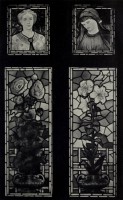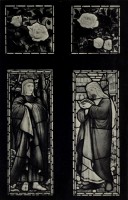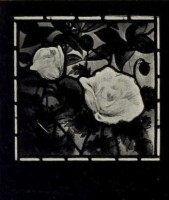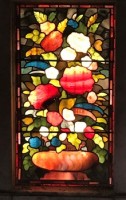The browser will either open the file, download it, or display a dialog.

The Metropolitan Museum of Art recently acquired a previously unknown stained glass window attributed to the workshop of Daniel Cottier (1837–91; fig. 1). This window, displaying flowers over a latticework trellis, joins three other figural windows from the same artist/workshop in the museum’s collection: two with an allegory of Spring, and the third, a double-light panel depicting two scenes from Alfred, Lord Tennyson’s The Lady of Shalott, following designs by the Dutch artist Matthijs Maris.[1]
Fig. 1, Daniel Cottier, Cottier & Co., Flowers on a Latticework Trellis, ca. 1877–80. Stained glass panel. The Metropolitan Museum of Art, Purchase, Barrie A. and Deedee Wigmore gift, 2020 (2020.1), New York. Image courtesy the Metropolitan Museum of Art.
Cottier was born in Glasgow and embarked on his career in stained glass there, working with some of the most prominent Scottish stained glass artists during the mid-nineteenth century. He also worked in London during the 1860s, when he came under the influence of the Pre-Raphaelites. Cottier set up his own independent studio in Edinburgh in the early 1860s and exhibited a “magnificent ornamental window” at the Paris Exhibition of 1867.[2] Two years later, Cottier was back in London and, like many artists of the period, he embraced multiple media, including furniture, decorated ceramics, and artistic interiors, as well as dealing in art, under the name Cottier & Co., Art Furniture Makers, Glass and Tile Painters. By 1873, he had set up an outpost in New York at 144 Fifth Avenue, where he catered to the growing taste for Aesthetic interiors throughout the United States and sold his artistic works, including windows for both ecclesiastic and domestic commissions. Consistent with the size of his operations, his workshops were extensive, with a number of individual artists, designers, and craftsmen working under the Cottier name. During the 1870s and 1880s, Cottier & Co. became a significant purveyor of stained glass for the home at a time when stained glass was considered an integral part of household decoration and an important contributor to the “artistic interior.”[3]
The newly acquired work at the Metropolitan Museum is a single-light vertical rectangular window and features a profusion of flowers—roses, poppies, white marguerites, and morning glories—over a bamboo trellis. It was discovered in Vancouver, Canada, at a small auction house, from whom the Metropolitan purchased it. Regrettably, the auction house was unable to provide any substantive provenance for the window, save that it had come from a “mansion in Ohio.” It seems most likely that this was a domestic window, although it is impossible to determine if that midwestern house was the window’s original site, or if it had been acquired on the secondary market. Nonetheless, it corresponds closely to a window originally found in another domestic setting: a six-light window made for the W. Watts Sherman house in Newport, Rhode Island, which is now in the collection of the Museum of Fine Arts, Boston (MFA; fig. 2).[4]
Fig. 2, Daniel Cottier, Cottier & Co., Morning Glories, ca. 1877–78. Six-panel stained glass window. Museum of Fine Arts, Boston, Gift of James F. and Jean Baer O’Gorman (1974.498c-d). Image courtesy of the Museum of Fine Arts, Boston.
The MFA window has an interesting history of attribution. When it was initially acquired by the museum in 1974, the window was ascribed to John La Farge (1835–1910). Indeed, there are compositional relationships with some of La Farge’s early windows, such as his window of peonies blowing in the wind (fig. 3), that made such an attribution plausible.[5] Cottier and La Farge were contemporaries and the two were active during the 1870s. They may have worked together in some capacity on the decoration of Trinity Church, Boston, to which both artists also contributed stained glass windows.[6] Cottier’s firm was commissioned in 1877–78 to provide four figural windows in the south transept, just prior to La Farge’s initial forays into stained glass. Although La Farge was working on the interior decoration of the church from 1876, it was not until the early 1880s that he produced four windows for Trinity, beginning with his Christ in Majesty, installed in 1883.
Fig. 3, John La Farge, Peonies Blown in the Wind, ca. 1880. Stained glass window. The Metropolitan Museum of Art, Gift of Susan Dwight Bliss, 1930 (30.50), New York. Image courtesy the Metropolitan Museum of Art.
Although there had been some studies of Cottier’s work in his home country of Scotland and in Australia in the 1970s and early 1980s,[7] at that time little was known of the artist’s multifaceted career in the United States outside of his role as an art dealer. The Metropolitan Museum’s exhibition In Pursuit of Beauty: Americans and the Aesthetic Movement was one of the first to showcase the artist’s contributions in the United States. Although the catalogue of the exhibition highlighted several windows by Cottier, it maintained the attribution of the MFA window to La Farge—an attribution that soon changed.
Several factors were involved in altering the attribution of the MFA window from Cottier to La Farge. First, the Watts Sherman house in which it originally was placed was built between 1877 and 1878, a moment when La Farge was only beginning his experiments in stained glass.[8] The Watts Sherman window showcases a competency and experience on the part of the glass artists who made it, shedding doubt on the possibility that it could have been made by La Farge at that early date. Another clue is present in the Watts Sherman house itself: although the MFA panels were removed from the house sometime in the early 1970s, there remained windows on the stair landing that were filled with quarry panes with simple black-on-yellow decoration achieved through the use of silver stain. Those quarries bear a direct relationship to other known Cottier windows. This raises the question: Why would Watts Sherman have commissioned two different artists to provide the stained glass in his house? Thirdly, the type of glass that is utilized in both the Watts Sherman and the Metropolitan windows is consistent with each other, but not with the work of La Farge. Furthermore, when one compares both windows to those of Cottier’s making that were illustrated in the sale catalogue of the contents of Cottier & Co., they relate closely to several of the windows documented by the firm (fig. 4).[9]
Both the MFA and Metropolitan windows feature essentially the same glass and techniques. For the distinctive rose and poppy blossoms, the studio used a flashed ruby-red glass and then partially etched the red layer to reveal the clear layer below (fig. 5). They then applied silver stain, which when fired turned the colorless layer a rich yellow. The color shift has the appearance of being integrally incorporated. As the Metropolitan Museum’s stained glass conservator, Drew Anderson, has noted, this was achieved by making a very gradual acid etching of the flashed pane, which lent to the transition a subtle gradation. In that way, the treatment of a single piece of glass is given an appearance of a soft transition of color within the glass itself. The silver stain may, in fact, have been applied not only to the etched area, but also across the red, in order to obtain an extra vibrancy. This effect would later, in the hands of La Farge and Louis C. Tiffany, be accomplished by melding together two different colors integrally within in a single glass pane.
Fig. 5, Detail of Daniel Cottier, Cottier & Co., Flowers on a Latticework Trellis, ca. 1877–80. Stained glass panel. The Metropolitan Museum of Art, Purchase, Barrie A. and Deedee Wigmore gift, 2020 (2020.1), New York. Image courtesy the Metropolitan Museum of Art.
Careful study of the new acquisition revealed some other unusual features.[10] The leaves at the top of the window were leaded separately. Near the bottom, the leaves have been painted on pieces of blue glass and their outlines have not been delineated by leading. They are darker, perhaps to give them the appearance of being in the shade. It is likely that the blue glass was also stained to provide the foliage a greener color. Another unusual feature are the branches that have been painted across some glass pieces, whereas in other areas they are leaded. All of these distinctive characteristics are also found on the MFA/Watts Sherman window.
Most of Cottier’s windows had figural subjects, as seen in the large numbers that were left in his New York shop when the firm closed and its contents were put up at auction in 1913.[11] Of the 242 lots of stained glass panels listed, only fourteen featured floral subjects. There are several apt comparisons of panels with quite similar renderings of the various blossoms found on the Metropolitan panel. When one compares, for example, the rose in full bloom with one found on a small panel illustrated in the catalogue (figs. 6, 7), the painting style is virtually identical. A similar relationship can be found in a small panel of morning glories. A possibility is that the window might have been part of the auction sale and installed at some later date in the Ohio house, but a careful comparison of the descriptions and dimensions of the windows listed did not produce a match.
Cottier’s career was cut short at the young age of fifty-three, and he was buried in New York at Woodlawn Cemetery. It was there that another floral window was recently discovered (fig. 8), which shows marked relationships with both the new Metropolitan window and that at the MFA, as well as several listed in the 1913 auction catalogue. Made for the mausoleum of British-born financier Henry Clews (1834–1923), the window shows a profusion of flowers in a low terracotta vase, without a trellis, and features roses, chrysanthemums, and morning glories. Its painterly details that define the leaves are similar to the treatment in the two windows under discussion. The dating of Clews’s window was at first somewhat problematic. If the mausoleum was built at the time of Clews’s death in 1923, it postdated Cottier’s years in business. However, the records at Woodlawn Cemetery indicate that plans for the Clews family mausoleum were drawn up on May 10, 1890,[12] a date that coincides with the death of Henry Clews’s young son, Robert Bower Clews, who died at the age of twelve of a cerebral hemorrhage. It is possible that Clews, who had a summer cottage—the Rocks, in Newport—might have been familiar with the Cottier windows in the Watts Sherman house and that they may have inspired him to commission the same firm for the windows of his family’s mausoleum. Both the Clews window and the recently acquired window by the Metropolitan add to the extensive known oeuvre of Daniel Cottier and his working method, as well as to the growing body of knowledge around this important nineteenth-century tastemaker.
Alice Cooney Frelinghuysen
Anthony W. and Lulu C. Wang Curator of American Decorative Arts,
The Metropolitan Museum of Art
[1] The Metropolitan Museum of Art, accession numbers 1995.330 (Spring); 2007.23 (Spring); 2016.72 (Lady of Shalott); 2020.1 (Flowers on a Latticework Trellis).
[2] Reports of Artisans Selected by a Committee Appointed by the Council of the Society of Arts to Visit the Paris Universal Exhibition, 1867, by Royal Society of Arts (Great Britain); Exposition universelle de 1867 à Paris (London: Bell, 1867).
[3] The literature on Cottier is scarce. He and his company Cottier & Co. are prominently featured in Doreen Bolger Burke, Jonathan Freedman, Alice Cooney Frelinghuysen et al., In Pursuit of Beauty: Americans and the Aesthetic Movement (New York: The Metropolitan Museum of Art and Rizzoli, 1986). In 1987, Margaret H. Hobler completed her (unpublished) MA thesis about Cottier: “In Search of Daniel Cottier, Artistic Entrepreneur, 1838–1891” (MA thesis, CUNY Hunter College, New York, 1987). Important insights and information are also found in Juliet Kinchin, Hilary Macartney, and David Robertson, Cottier’s in Context: Daniel Cottier, William Leiper and Dowanhill Church, Glasgow (Edinburgh: Historic Scotland, 2011). There is also a forthcoming monograph on Cottier: Petra ten-Doesschate Chu and Max Donnelly, with Andrew Montana and Suzanne Veldink, Daniel Cottier: Designer, Decorator, Dealer (New Haven, CT: Paul Mellon Centre for Studies in British Art and Yale University Press, 2021).
[4] Museum of Fine Arts, Boston, accession number 1974.498a-f.
[5] When the Metropolitan Museum borrowed the window for its exhibition In Pursuit of Beauty: Americans and the Aesthetic Movement in 1986, it came with the La Farge attribution, which I published in the accompanying publication. See Alice Cooney Frelinghuysen, “A New Renaissance: Stained Glass in the Aesthetic Period,” in Burke, Freedman, Frelinghuysen et al., In Pursuit of Beauty, 186–88, 190.
[6] See Virginia Chieffo Raguin, “Decorator: John La Farge,” in The Makers of Trinity Church in the City of Boston, James F. O’Gorman (Amherst: University of Massachusetts Press, 2004), 118–37; and James L. Yarnall, John La Farge, A Biographical and Critical Study (Burlington, VT: Ashgate Press, 2012), 158–59.
[7] See Martin Harrison, Victorian Stained Glass (London: Barrie & Jenkins, 1980), 46–49, 56–62, 69–72; Michael Donnelly, Glasgow Stained Glass: A Preliminary Study (Glasgow: Glasgow Museums and Art Galleries, 1981); Geoffrey M. Down, “Nineteenth Century Stained Glass in Melbourne” (MA thesis, Melbourne University, 1975); and Beverley Sherry, “Secular Stained Glass in Australia,” Australian Antique Collector, June–December 1983, 44–49.
[8] The Watts Sherman house is now owned by Salve Regina University, and it is used as a residential dormitory.
[9] Illustrated Catalogue of the Artistic Property, Fine Antique and Modern Furniture, Important Flemish Tapestries, Stained Glass, Textiles and Other Objects of Household Utility and Embellishment of the Well-Known House of Cottier and Company of New York, auction cat. (New York: American Art Galleries, 1913), n.p., lots 830, 854, 964.
[10] I thank Drew Anderson, stained glass conservator, The Metropolitan Museum of Art, for his insights into this window.
[11] The Artistic Property of the Well-Known House of Cottier and Company, New York, auction cat. (New York: American Art Galleries, 1913).
[12] I am grateful to Susan Olsen, The Woodlawn Cemetery & Conservancy, Bronx, New York, for sharing the information on the Henry Clews mausoleum.






